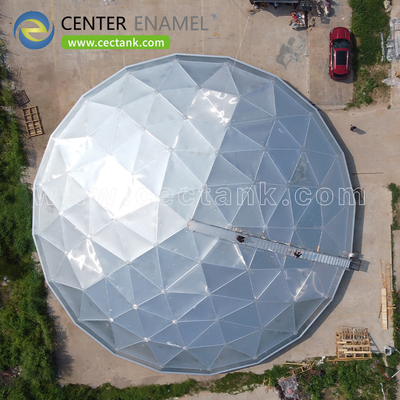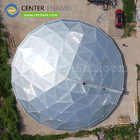-
Glass Fused Steel Tanks (248)
-
Stainless Steel Bolted Tanks (148)
-
Fusion Bonded Epoxy Tanks (68)
-
Galvanized Steel Tanks (44)
-
Aluminum Dome Roofs (82)
-
Waste Water Storage Tanks (218)
-
Anaerobic Digester Tank (203)
-
Industrial Water Tanks (178)
-
Glass Lined Water Storage Tanks (181)
-
Bolted Steel Tanks (167)
-
Sludge Storage Tank (118)
-
Biogas Storage Tank (163)
-
Liquid Storage Tanks (173)
-
Leachate Storage Tanks (140)
-
Agricultural Water Storage Tanks (175)
-
Fire Water Tank (168)
-
Grain Storage Silos (119)
-
Biogas Plant Project (43)
-
Wastewater Treatment Projects (98)
The history of Aluminum domed roof for Liquid storage tanks
| Place of Origin: | China |
| Brand Name: | Center Enamel |
| Certification: | ISO 9001 |
| Model Number: | Aluminum Dome Roofs |
| Minimum Order Quantity: | 1 |
| Price: | 100-50000 |
| Packaging Details: | 2000 |
| Delivery Time: | 8 weeks |
| Payment Terms: | L/C, T/T |
| Supply Ability: | 6000 |
|
Detail Information |
|||
| Place of Origin | China | Brand Name | Center Enamel |
|---|---|---|---|
| Certification | ISO 9001 | Model Number | Aluminum Dome Roofs |
| Material: | Aluminum | Structure: | Self-supporting Structure |
| Corrosion Resistant: | High Corrosion Resistant | Maintenance: | Virtually Maintenance Free |
| Installation: | Quick Field Installation | Design: | Clear Span Design |
Product Description
The history of Aluminum domed roofs for Liquid storage tanks
The aluminum domed roof above ground storage tanks (AST) are now in use worldwide. Although dating back nearly a century, the reasons for their use of oil tanks have evolved over the past 40 years.
In 1968, the first aluminum dome was installed on a water storage tank, in 1969 on a sewage tank, and in 1977 an oil tank was installed by the same company. It was not until 1989 that API formulated API 650 Appendix G: "Structurally Supported Aluminum Dome Roofs".
In the United States, the initial use of aluminum domed roof storage tanks (ADRT) for petroleum was as a weather cover to prevent snow and ice on the deck of the outer floating roof (EFR). The other reason is the ratio of strength to span and its lightness, which makes it ideal for the use and modification of existing tanks.
An example of this was in the early 1960s, when Colonial, the owner of a tank farm in the United States, had only steel EFR in their tank farm. By 1978, they evaluated several roof replacement options and decided to adopt an ADRT with an aluminum internal floating roof (IFRS) deck. This is used as the company's standard roof design for roof replacement and new storage tanks.
By 1980, some tank owners began to cover tanks and replaced EFR with low-profile internal floating roofs (IFRS). This increases work capacity, reduces emissions, reduces product vapor loss due to evaporation, and prevents wind-induced VOCs for design reasons related to EFR. Studies have proved that ADRT is determined to improve fire safety, and more than 70% of large-diameter AST fires occur in EFR. At the time of writing this document, a fire broke out on May 22, 2020, which damaged the crude oil AST with EFR of Hengyuan Refining Company in Port Dickson, Malaysia.
ADRT is structurally supported, which avoids internal steel roof pillars or pillars, thereby avoiding the pillar penetration, corrosion and coating costs associated with steel roofs. AST operators report that the internal tank temperature of the tank equipped with geodetic domes is lower, so product evaporation is reduced due to the lower product temperature. By 1982, the geodesic dome device expanded south to Brownsville, Texas. By 1985, gasoline additives and water treatment promoted the conversion of more EFRTs to dome EFR or the complete replacement of EFR with IFR and the modification of it with a geodesic dome.
The API Evaporation Loss Estimation Committee (CELE) developed Chapter 19 of the Petroleum Measurement Standards Manual (MPMS). It contains emission factors for various AST configurations. The example emission calculations in MPMS Chapter 19.2, Section 5—using an EFR of 30.48 meters (100 feet) in diameter as the baseline—showed a reduction of IFR emissions to 35% and dome EFR emissions to 10%.
In 2006, the API CELE study collected thermal data from geodetic dome AST and EFR storage tanks located in Dammam, Saudi Arabia and Edmonton, Alberta. The "average overall temperature" of EFR tanks is slightly lower-EFR loses heat quickly at night, while ADRT does not, but the surface liquid temperature peaks during the day and day. This resulted in a reduction in the overall emissions of the dome EFR storage tank.
API MPMS 19.4 includes the thermal study information in Annex I and a table that compares the excellent reflection properties of polished aluminum and steel painted white (or other colors).
In the United States, states and local jurisdictions issue air permits with the goal of further reducing VOC. Considering only wind reduction factors, before the high reflectivity and low emissivity of aluminum bring thermal benefits, in order to reduce the emission inventory, the Southern California South Coast Air Quality District issued SCAMD Rule 1178 in 2001. It pointed out that the steam around storage tanks must be controlled and regulated. It considered aluminum geodesic domes to be the "perfect" solution, so it needed to convert EFR tanks to dome AST.
Initially, the factors that pushed the industry to cover storage tanks were snow, rain, and possible sandstorm conditions. However, another benefit is reduced steam loss, lower product temperature, and emissions. Currently, lower VOC and clean air requirements are the driving forces for improving ADRT.
In general, the originality, engineering, and design of the geodesic dome and the benefits it brings to the tank industry as a long-term asset are very timely.




